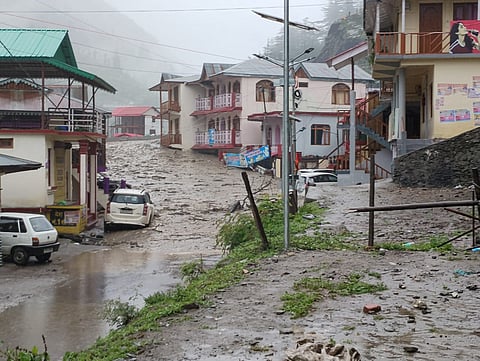
- Destinations
- Experiences
- Stay
- What's new
- Celebrating People
- Responsible Tourism
- CampaignsCampaigns
- Subscribe
- Buy Now

The situation in North Bengal continues to unfold in the aftermath of last week’s flash floods and landslides triggered by heavy rain. From damaged tea gardens and wildlife casualties to displaced families and disrupted infrastructure, the impact has been widespread. Here's a look at the latest on the ground—including early estimates of destruction, official responses, and the slow but surprising return of tourists to parts of the hills.
The recent spell of relentless rain across North Bengal has unleashed a wave of destruction with floods and landslides, particularly in the tea-growing regions of the Darjeeling hills. At least 30 to 35 tea gardens have suffered extensive damage, with reports of plantation areas being washed away, labourers’ homes destroyed, and even casualties among the workers.
Distressed tea estate owners have begun convening emergency meetings to assess the situation and chart a path for recovery. The damage is not merely financial—there is growing concern for the long-term viability of several plantations that have been left ravaged by landslides and flooding.
Preliminary assessments by the state government estimate that over 18,500 hectares of land have been damaged by floodwaters across the region. Jalpaiguri district alone accounts for around 14,000 hectares of this total. The human toll has also been significant. Approximately 9,500 people have been displaced and are currently sheltering in relief camps. Jalpaiguri district houses over 7,000 of these displaced individuals in 18 different camps, including around 2,000 people in Nagrakata’s Bamandanga. A further 2,000 have taken refuge in eight camps set up in Alipurduar district.
According to media reports, roads in Darjeeling are being gradually cleared following recent landslides triggered by heavy rain. Restoration efforts have ensured that most major routes and tourist access points are now operational. Key roads leading to Tiger Hill, the Padmaja Naidu Himalayan Zoological Park, and the Japanese Temple have already been cleared. Minor blockages in these areas were addressed promptly, with some cleared within hours. Rohini Road remains under repair under the supervision of the Gorkhaland Territorial Administration (GTA). Additionally, access to Sandakphu, which had been temporarily restricted, has also been restored, further easing movement for visitors.
The Dooars region, known for its lush forests and vibrant biodiversity, has not been spared. Gorumara and Jaldapara National Parks—both prominent wildlife reserves—have been hit hard by flooding rivers that run through them. According to reports, local conservation groups have confirmed the discovery of several animal carcasses across Jalpaiguri and Alipurduar districts in the aftermath of the downpour. At least one rhinoceros, three Indian gaur (bison), and a sambar deer are feared dead. Officials fear the toll on wildlife may rise as forest teams access deeper, flood-affected areas.
According to some media reports, the Geological Survey of India (GSI) confirmed that it had issued a high-risk landslide alert for Darjeeling on October 4—just hours before the region was battered by torrential rain that triggered multiple landslides. The warning was based on meteorological forecasts pointing to high rainfall, already saturated soil conditions, and continued vulnerability following months of monsoon activity. GSI scientists also highlighted the escalating risk posed by unplanned urban expansion and human interference, especially the construction of structures across natural drainage channels that obstruct water flow.
Despite damaged travel routes, landslide fears, and flood-ravaged landscapes, some reports say that tourists are slowly returning to the hills. Signs of cautious revival are beginning to appear. This renewed tourist interest, though welcomed by local businesses and communities dependent on tourism, also raises difficult questions about the long-term sustainability of development in these ecologically fragile hills.
Much of the unregulated building activity in North Bengal—new hotels, homestays, widened highways, and other tourism-driven infrastructure—has contributed to environmental stress in an already geologically unstable region. In many places, natural drainage channels have been blocked by construction, increasing the likelihood of flash floods and landslides during heavy rainfall.
Environmental experts have repeatedly warned that the Eastern Himalayas, due to their topography and climatic conditions, are particularly vulnerable to such disasters. The rapid urbanisation fuelled by tourism demand has often come at the cost of scientific planning and ecological safeguards. As tourists return and the sector shows signs of recovery, the question looms larger than ever: is tourism a blessing or a curse for the region?
While it undoubtedly sustains livelihoods and brings economic vitality, its current trajectory—if left unchecked—may be pushing the very landscape that draws tourists to the brink of collapse. The challenge now lies in finding a balance: preserving the region’s natural beauty, culture, and ecological health while still allowing for responsible and sustainable tourism growth.
What areas have been worst affected by the North Bengal floods?
Areas in Darjeeling, Kalimpong, along with parts of Jalpaiguri, Alipurduar, and the Dooars, have suffered severe damage from landslides and flooding.
Has wildlife been impacted by the floods?
Yes. Several animals, including a rhinoceros, Indian gaur, and a sambar deer, have died in Gorumara and Jaldapara National Parks due to flooding.
Did authorities issue any warning before the landslides?
The Geological Survey of India issued a high-risk landslide warning for Darjeeling on October 4, just hours before the heavy rainfall triggered multiple slides.
Is tourism contributing to the region's ecological problems?
Experts say unplanned construction linked to tourism—such as hotels, roads, and blocked drainage paths—is worsening flood and landslide risks in the hills.
Why is tourism-linked construction seen as a problem in North Bengal?
Much of the new construction in hill areas—hotels, roads, and widened highways—is driven by growing tourism. Experts warn that this often unregulated development blocks natural drainage channels and destabilises slopes, increasing the risk of landslides and floods.
